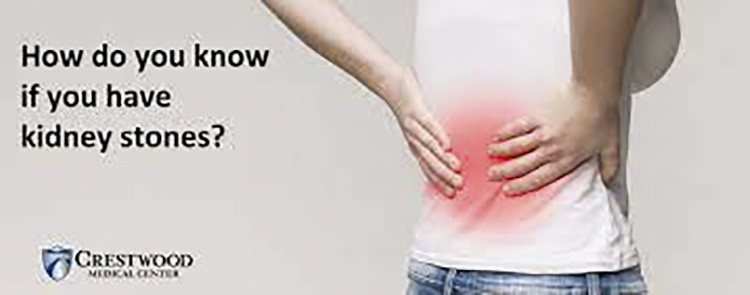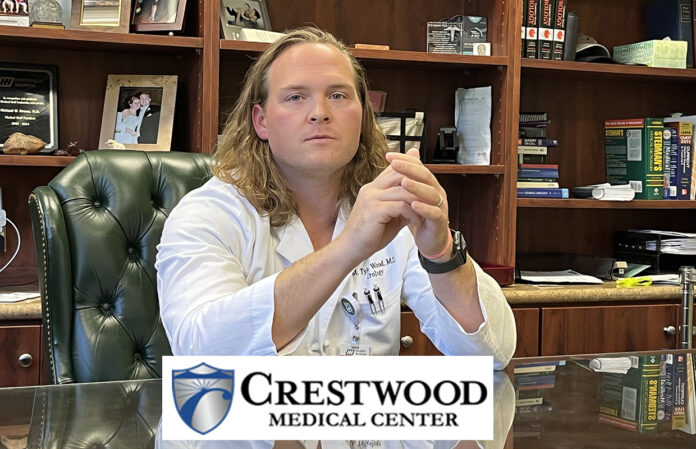HUNTSVILLE — In honor of March as National Kidney Month, Crestwood Medical Center urologist Dr. Tyler Wood shared some stunning facts about people who have kidney stones – symptoms, causes, medical options and prevention.
If you suffer from chronic pain caused by recurring kidney stones, or even if you have never had the painful experience yourself, you should know kidney stones are alarmingly common. It is estimated that more than one in 10 people will have a kidney stone at some point in their lives and the southeastern United States – yes, Alabama included – has higher incidences of kidney stones than anywhere else in the country.
Kidney stones start as a very tiny uric acid crystal forming inside the kidney. Over time, calcium deposits form on top of that and, over several years, it will slowly grow to the point where it can’t be passed.
“It’s not uncommon for us to see stones two, three, and four centimeters,” Wood said. “Kidney stones create a lot of severe pain. In fact, I have had female patients tell me trying to pass a kidney stone is more painful than childbirth.
“And for those who have recurring stones, it becomes a quality-of-life issue.”
Some the symptoms of stones are acute upper back pain that is so severe, the patient cannot function. Nothing lessens the pain, and it often causes nausea and vomiting, ending in a visit to the Emergency Room to try and get the pain under control.
“A host of factors can cause kidney stones, the most common is chronic dehydration, but there are other contributors,” Wood said.
Most people, especially in the South he said, are chronically dehydrated and don’t know it, probably because of the heat and high humidity.
“Staying hydrated is one of the best ways to prevent stones, drinking enough water to make 2.5 liters of urine per day will decrease risk,” he said. “If your urine is clear, you are probably getting enough fluid intake.”
A host of other factors can also contribute to the condition including genetics, which you cannot change, and diet makes a difference, too, he said.
“Most kidney stones are made of calcium oxalate so a low oxalate diet can help,” Wood said.
High oxalate foods include greens, legumes, potatoes, beets, and some fruits and nuts.

There are several methods doctors use to treat kidney stones.
“Thirty years ago, people had open incisions,” said Wood. “We would go in there and take out the stone, but thankfully technology has advanced so we do not have to be that invasive.
“What we do ultimately depends on the size of the stone and its location, whether it is in the kidney or in the upper section of the urine tube.
“The most common procedure which has been around for 20 years is shock wave lithotripsy.”
This procedure targets the stone using ultrasound to fragment the stones into tiny pieces so the patient can pass them while urinating without too much trouble.
Further advancements in technology over the last five to 10 years has introduced a newer technique called ureteroscopy for stones that are lodged in the urine tube or are unsuccessful at passing.
Urologists use a ureteroscope, which travels up the ureter to the stone, allowing the urologists to watch on a video monitor using fiber optics. Instead of using sound waves, the scope uses the energy pulse of a laser beam applied directly to the stone to chip it away into tiny pieces.
Another method uses a sound wave to pulverize the stone practically into dust much more quickly.
Crestwood has a new laser for this purpose and Wood said they have decreased surgical time by about 20% and has significantly increased their stone clearance rate.
“Percutaneous nephrolithotomy is a procedure in which we actually go through the patient’s back,” he said. “We’ll make a small incision and insert a sheath directly into the back. We have a device that runs up through the sheath that has a camera and when we encounter the stone, we use a device called Trilogy that uses ultrasound and pneumatic technology to fragment the stone into really small pieces.”
He said the device also has a suction device so once the stone is fragmented, the doctor can suck the pieces out, so you don’t have to pass it.
Small stones can pass within a week, but a stone four, five, six millimeters can take a month or more and some folks are willing to wait.
If you suspect kidney stones are the culprit of your pain, you should see an urgent care doctor or visit an emergency room, followed by an in-office visit with a urologist as soon as possible.
A doctor can assess your condition and put together a treatment plan that manages the acute stone episodes. Once that is under control, you begin working on how to prevent them in the future.
“The pain is often so great, that’s what most people really want to know when they experience their first misery episode,” said Wood. “They want to know why it happened and how can they keep it from happening again.”
Don’t miss out! Subscribe to our email newsletter to have all our smart stories delivered to your inbox.



